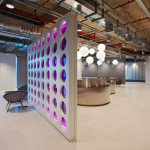Hybrid vs office worker: who’s more likely to score the promotion?

As the hybrid workplace continues to evolve, new habits and styles of working have begun to emerge. With unprecedented flexibility and a focus on well-being, employees are creating their own, unique experience of work which aligns with their personal needs and levels of productivity, outside of the traditional 9-5.
Workplace consultancy firm Future X Collective has identified five key employee archetypes through their extensive client engagement over the last three years, that have emerged in 2023 and what they mean for companies and employees. These archetypes reflect the changing nature of work and the ways in which people are adapting to the hybrid workplace.
“Much about the way we have traditionally worked has shifted over the past three years. More than ever employees want autonomy and the ability to define their own way of work and leverage the available flexibility,” According to Future X Collective Co-Founder Angela Ferguson.
“As a result, we’ve seen new employee archetypes emerge. It is incredibly important that companies understand these archetypes so that they can extract the most out of their team members and create an engaging, productive and healthy work environment for all.”
Through their extensive research with hundreds of employees and employers, Future X Collective has identified five key employee archetypes that have emerged from hybrid working, along with the individual benefits and challenges of each style:
- The Digital Nomad
The first new employee archetype is the remote worker. This includes employees who work primarily from home or another remote location but may occasionally come into the office. Remote workers reap many benefits, including increased flexibility, reduced commuting time, and the ability to work from anywhere. However, they also face unique challenges, such as feeling isolated from their colleagues and a lack of face-to-face interaction with colleagues.
Angela adds, “If your business is worried about remote workers, ask yourself whether your physical workplace is offering genuine, meaningful reasons for people to come in like collaboration or team brainstorming?
“The current workplace post-pandemic is less about ‘command and control’ and more about creating an experience of work that is empowering and authentic for individuals and teams.”
- The Office Chameleon
The second new employee archetype is the hybrid worker, which includes employees who split their time between working in the office and working from home or another remote location. Hybrid workers get the best of both worlds, as they enjoy the benefits of remote work while also being able to collaborate with colleagues in person. Yet, they also face challenges, such as managing their work-life balance and finding a comfortable and productive work environment, with good wifi, appropriate ergonomics and the right management systems to be able to curate their experience of work.
- The Wanderlust Worker
The third new employee archetype identified by Future X Collective is the deskless worker, which includes employees who don’t have a traditional office desk but may work in a variety of different spaces, including remote locations, co-working spaces, or other shared spaces. Deskless workers offer companies increased flexibility, as they can work from a variety of locations, but they also face similar challenges to The Hybrid Worker, which is finding a space where they can remain focused.
Furthermore, Angela adds: “You may find that The Deskless Worker flourishes in the ‘Third Space’ which offers a creative alternative to the home or office environment. This can look like cafes, libraries or parks, anything out of the ordinary that may stimulate the imagination as well as promote health and wellbeing.”
- The Taskmaster
The fourth new employee archetype is the on-demand worker, which includes employees who work on a project-by-project basis, rather than having a traditional full-time job. As work becomes more flexible, the appeal of the on-demand worker is attractive. They may work from a variety of locations, including remote and in-person. On-demand workers offer companies increased flexibility, as they can be hired on an as-needed basis, but they also come with their own set of challenges, such as managing their work-life balance and ensuring they have the right technology to be productive while working from different locations.
- The Insight Instigator
The fifth and final employee archetype identified by Future X Collective is the knowledge worker, which includes employees who work primarily with knowledge and information, such as software developers, data scientists, and researchers. Knowledge workers offer companies increased expertise and creativity. The knowledge worker faces similar issues around productive technology use and work-life balance as the on-demand worker.
Angela concludes; “These new employee archetypes in the hybrid workplace offer companies and employees a variety of benefits and challenges. With the right strategies and tools in place, companies can create a workplace that supports their employees and helps them thrive.”








